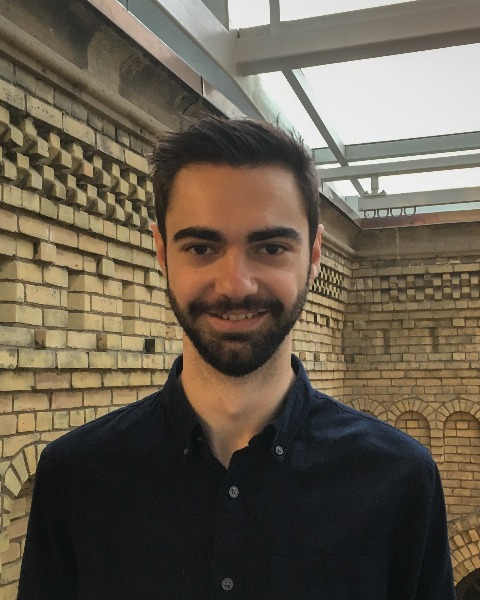Drug Delivery
(I-339) Dual targeted, layer-by-layer (LbL) electrostatically assembled nanoparticles cross the blood brain barrier to treat glioblastoma brain tumors
.jpg)
Nicholas Lamson, PhD (he/him/his)
Postdoctoral Associate
Massachusetts Institute of Technology
Cambridge, Massachusetts, United States
Andrew Pickering (he/him/his)
Ph.D. Candidate
Massachusetts Institute of Technology
Cambridge, Massachusetts, United States- PG
Priya Ganesh
Undergraduate Researcher
Massachusetts Institute of Technology, United States - MM
Michael Marand
Research Technician
Massachusetts Institute of Technology, United States - KD
Kate Dolph
Undergraduate Researcher
Massachusetts Institute of Technology, United States - JW
Jeffrey Wyckoff (he/him/his)
Research Specialist
Massachusetts Institute of Technology, United States - JS
Joelle Straehla
Clinical Investigator
Massachusetts Institute of Technology, United States - NB
Natalie Boehnke
Assistant Professor
University of Minnesota, United States - PH
Paula Hammond
Professor
Massachusetts Institute of Technology, United States
Presenting Author(s)
Co-Author(s)
Primary Investigator(s)
Brain tumors and neurological diseases are the leading global cause of years of life lost worldwide, and the second leading cause of death. However, development of new treatments for glioblastomas, the most commonly occurring brain tumors, has been particularly challenging due to poor drug transport across the blood-brain barrier (BBB) – the specialized vascular lining of the central nervous system. As a result, 95% of newly discovered candidate therapies are excluded from entering the brain, and there is a critical need to develop drug carriers that can transport therapeutic cargoes across the BBB. Here, we leverage the modular layer-by-layer (LbL) process of self-assembling nanoparticles to probe how surface chemistry, as well as active targeting can be used to improve cargo accumulation across the blood brain barrier and subsequently into glioma cells.
Materials and Methods::
We begin by constructing a layer-by-layer electrostatically assembled library of liposome-based nanoparticles (LbL-NPs) with six rationally selected outer layer surface chemistries – carboxymethyldextran, hyaluronate, polyacrylate, polyaspartate, polyglutamate, and polysialate – as well as the LRP1 targeting peptide Angiopep-2. We screen this library for both Transwell transport using the immortalized human cerebral microcapillary endothelium cell line hCMEC/D3 as a model of the BBB, and for uptake in GBM6 patient-derived glioma cells. In parallel, we examine in vivo nanoparticle permeability across the BBB using intravital imaging in mice, as well as biodistribution into patient-derived xenograft (PDX) brain tumors.
Results, Conclusions, and Discussions::
First, we demonstrate that specific surface layer polymers – especially hyaluronate – improve uptake across the blood brain, as well as improve nanoparticle affinity to and specificity for uptake into cancer cells. Next, we show that Angipop-2, electrostatically adsorbed to the nanoparticle surface, further boosts both blood brain barrier transport and glioma uptake without a need for covalent ligand conjugation. Finally, we demonstrate that peptide adsorption onto nanoparticle surfaces improves biodistribution into the brain in healthy mice, as well as into intracranially implanted tumors. Taken together, this work provides a proof-of-concept that electrostatic adsorption of targeting peptides onto nanocarriers provides a simple and modular targeting strategy to improve glioblastoma tumor accumulation of drug cargoes. Ongoing experiments aim to demonstrate that the LbL nanoparticles with adsorbed peptides provide the greatest survival benefit in treating PDX brain tumors - using the MEK inhibitor trametinib as therapeutic cargo - as compared to free drug and non-targeted nanocarriers.
Acknowledgements (Optional): :
This work is supported by Cancer Research UK grant number C42454/A28596, and we would like to acknowledge use of core facilities, especially the Microscopy, Flow Cytometry, High Throughput Sciences, and Integrated Genomics and Bioinformatics cores, in the MIT Koch Institute Swanson Biotechnology Center, which is supported by the Koch Institute Core Grant P30-CA14051 from the NCI. N.G.L. is also supported by a postdoctoral fellowship from the Ludwig Center at MIT’s Koch Institute for Integrative Cancer Research
References (Optional): :
